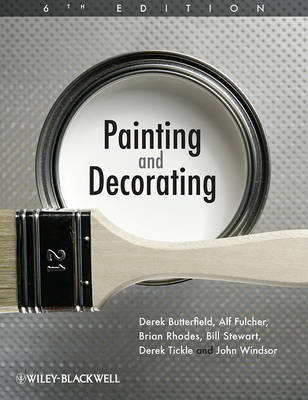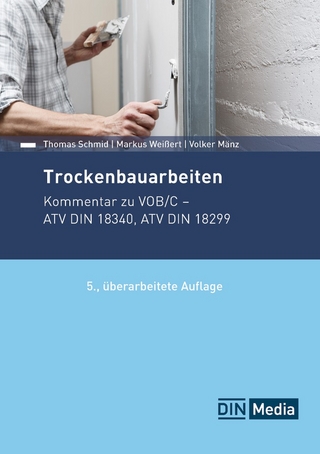
Painting and Decorating
Wiley-Blackwell (Verlag)
978-1-4443-3501-9 (ISBN)
The content covers the knowledge evidence for both National Vocational Qualifications (NVQs) and Scottish Vocational Qualifications (SVQs) in painting and decorating. The book?s extensive but concise information will also make it an excellent reference for practising painters and decorators.
provides essential job knowledge for NVQ Levels 2 and 3 students of painting and decorating
full colour edition of this highly successful text, first published in 1975
thoroughly revised to cover new developments in tools, equipment, materials, scaffolding, and health and safety
completely new colour illustrations with information presented in simple, structured information sheets
also of interest to the professional needing specialist up-to-date information
About the Author Derek Butterfield, formerly Curriculum Manager for Construction Crafts at Reading College
Editor’s note xi
Preface to the sixth edition xii
Part 1 Tools and Equipment 1
1.1 Small tools and equipment 3
1.1.1 Painters’ hand tools 3
1.1.2 Paint containers 7
1.1.3 Mechanical hand tools 8
1.1.4 Burning-off equipment 11
1.1.5 Brushes: components and types 12
1.1.6 Paint rollers 15
1.1.7 Paint pads and mittens 19
1.1.8 Paperhangers’ tools and equipment 19
1.1.9 Graining, marbling and broken-colour tools and brushes 22
1.1.10 Signwriting and decorative painting tools and brushes 25
1.1.11 Gilding tools and brushes 28
1.1.12 Texture-painting tools 29
1.2 Stripping and cleaning 31
1.2.1 The steam stripper 31
1.2.2 Flame-cleaning 32
1.2.3 Blast cleaning 33
1.3 Spraying 37
1.3.1 The spray gun 37
1.3.2 Containers for spraying 40
1.3.3 Compressors, receivers, transformers 42
1.3.4 Hoses and connections 44
1.3.5 Types of spray system 46
1.3.6 Airless spray 49
1.3.7 High-volume low-pressure spray (HVLP) 52
1.3.8 Cleaning, maintenance and storage of spray equipment 53
1.3.9 Spray guns for special purposes 54
1.4 Power sources 57
1.4.1 Compressed air 57
1.4.2 Electricity 58
1.4.3 Gases 60
1.4.4 The internal combustion engine 61
Part 2 Surface Coatings and Specialist Materials 65
2.1 Introduction 67
2.1.1 Volatile Organic Compounds (VOCs) – 2010 Legislation 67
2.1.2 Composition 68
2.1.3 Pigments and extenders 70
2.1.4 Film-formers 71
2.1.5 Thinners and driers 77
2.1.6 Properties of paint 79
2.2 Primers, undercoats and stoppers 81
2.2.1 Acrylic primer/undercoat 81
2.2.2 Alkali-resisting primer 81
2.2.3 Aluminium wood primer 82
2.2.4 Quick-drying acrylic metal primer 82
2.2.5 All-purpose primer 83
2.2.6 Calcium plumbate primer 83
2.2.7 Etch primer 84
2.2.8 Wood primer 84
2.2.9 Preservative primer 85
2.2.10 Knotting solution 85
2.2.11 Flexible filler 86
2.2.12 Spirit-based aluminium sealer 86
2.2.13 Primer sealer 86
2.2.14 Stabilising primer (also called stabilising solution) 87
2.2.15 Plaster sealer 87
2.2.16 Red lead primer 87
2.2.17 Zinc chromate metal primer 88
2.2.18 Zinc phosphate metal primer 88
2.2.19 Zinc-rich primer and zinc-rich epoxy primer 89
2.2.20 Alkyd undercoat 89
2.3 Finishing paints 91
2.3.1 Interior and exterior metallic paints (formerly bronze/aluminium paint) 91
2.3.2 Eggshell or satin finish 91
2.3.3 Matt emulsion paint 92
2.3.4 Vinyl silk emulsion 93
2.3.5 Gloss finish 93
2.3.6 Water-based gloss 94
2.3.7 Multi-colour finish 94
2.3.8 Masonry paint 96
2.3.9 Cellulose coating 97
2.3.10 Moisture-vapour permeable (MVP) or microporous coatings 97
2.4 Special paints 99
2.4.1 Anti-condensation paint 99
2.4.2 Anti-graffiti paint 99
2.4.3 Anti-fungal paint 100
2.4.4 Bituminous paint 100
2.4.5 Cement paint 101
2.4.6 Chlorinated rubber paint 102
2.4.7 Acrylated rubber paints 102
2.4.8 Road line paint 103
2.4.9 Machinery enamel 103
2.4.10 Floor paint (single pack) 103
2.4.11 Damp-proofing compound 104
2.4.12 Epoxy resin paint 104
2.4.13 Flame-retardant paint 105
2.4.14 Micaceous iron oxide paint 106
2.4.15 Fluorescent and luminescent paints (fluorescent and phosphorescent types) 106
2.4.16 Dry-fall paint/dry-fog paint 107
2.4.17 Blockfiller 107
2.4.18 Hygienic coatings 107
2.4.19 Polyurethane paint 108
2.4.20 Texture-effect paint 108
2.4.21 Relief-texture paint (interior) 109
2.4.22 Self-cleaning paint 110
2.4.23 Heat-resistant paint 110
2.5 Clear finishes and wood treatments 112
2.5.1 Wood preservatives 112
2.5.2 Wood stains (translucent) 113
2.5.3 Wood stains (opaque) 113
2.5.4 Oil resin varnishes 113
2.5.5 Interior varnishes 114
2.5.6 Water-repellent solution 114
2.5.7 Spirit varnish 115
2.5.8 Graining and marbling materials 115
2.6 Paint defects 117
2.6.1 Defects of surface coatings 117
2.6.2 Defects in the tin 120
2.7 Gilding and bronzing materials and defects 125
2.7.1 Gilding 125
2.7.2 Bronzing 126
2.7.3 Gilding defects 127
2.8 Stencil and masking materials 129
2.8.1 Stencil-plate materials 129
2.8.2 Other stencil materials 130
Part 3 Preparation of Surfaces for Paint and for Clear Finishes 131
3.1 Abrasives 133
3.1.1 Coated abrasives 133
3.1.2 Abrasive powders and other abrasives 135
3.2 Making good 136
3.2.1 Stopper 136
3.2.2 Filler 136
3.3 Preparation of previously painted surfaces 139
3.3.1 Unsound surfaces 139
3.3.2 Sound surfaces 140
3.4 Preparation of new, stripped or untreated surfaces 142
3.4.1 Properties of building materials 142
3.4.2 Very absorbent surfaces 142
3.4.3 Absorbent surfaces 145
3.4.4 Non-absorbent surfaces 147
3.4.5 Chemically active surfaces 147
3.4.6 Corrodible surfaces 149
3.4.7 Bleeding and non-drying surfaces 153
3.5 Natural wood finishes 155
3.5.1 Preparation of natural wood surfaces 155
3.5.2 Finishes 156
3.6 Surface and paint film defects 157
3.7 Preparation of surfaces for graining, marbling and surface texturing 166
3.8 Preparation of surfaces for gilding and bronzing 167
Part 4 Surface Coverings 169
4.1 Preparation of surfaces for surface coverings 171
4.2 Adhesives 173
4.2.1 Starch paste 173
4.2.2 Cellulose paste 173
4.2.3 Starch ethers or starch-based 173
4.2.4 PVA and acrylic adhesives 174
4.3 Preparatory papers 175
4.3.1 White lining paper 175
4.3.2 Glass fibre 175
4.4 Flat papers 177
4.4.1 Grounds 177
4.5 Embossed papers 179
4.5.1 Dry embossed paper 179
4.5.2 Wet embossed paper 179
4.6 Relief papers 181
4.6.1 Ingrains: woodchip, oatmeal 181
4.6.2 Relief or blown vinyls 181
4.7 Washable papers 182
4.7.1 Ordinary washable paper 182
4.7.2 Vinyl paper 182
4.7.3 Paper coated after hanging 182
4.7.4 Pre-pasted (ready-pasted) paper 183
4.7.5 Photo murals 183
4.8 Decorative laminates 184
4.8.1 Flock papers 184
4.8.2 Wool strand and weftless materials 184
4.8.3 Paper-backed hessian 185
4.8.4 Grasscloth 185
4.8.5 Cloth-backed vinyl 185
4.8.6 Silk 186
4.8.7 Lincrusta 186
4.8.8 Metallic foils 187
4.8.9 Cork 188
4.9 Defects of surface coverings 189
4.10 Glossary of terms 193
4.11 International performance symbols 196
Part 5 Scaffolding 197
5.1 Ladders, trestles, stepladders 199
5.1.1 Ladders 199
5.1.2 Ladder attachments 200
5.1.3 Roof ladder 200
5.1.4 Trestles 201
5.1.5 Stepladders 202
5.1.6 Fixed-leg adjustable steel trestles 202
5.1.7 Hop-ups 203
5.2 Boards, staging, working platforms 204
5.2.1 Scaffold boards 204
5.2.2 Lightweight staging 204
5.2.3 Classes of portable plant 205
5.3 Scaffolding 206
5.3.1 Tubular components 206
5.3.2 System or unit scaffold 208
5.3.3 Independent scaffold 210
5.3.4 Putlog scaffold 211
5.3.5 Birdcage scaffold 211
5.3.6 Slung scaffold 212
5.3.7 Truss-out scaffold 214
5.4 Ropes, knots 215
5.4.1 Types of rope 215
5.4.2 Knots 215
5.5 Safety equipment 217
5.5.1 Safety belts, harnesses 217
5.5.2 Safety nets and sheets 218
5.6 Statutory obligations 220
Part 6 Safety, Health and Welfare 221
6.1 Health and safety at work 223
6.1.1 Health and Safety at Work Act 223
6.1.2 Health-and-safety regulations 223
6.2 Fire precautions 229
6.2.1 Common causes of fire 229
6.2.2 Fire-fighting 230
6.2.3 Treatment for burning clothing 230
6.3 Storage of materials 232
6.4 Lead paint 235
6.4.1 Control of Lead at Work Regulations 2002 (‘CLAW’) 235
6.4.2 Removal of paint systems containing lead 236
6.5 Hygiene 237
6.5.1 General principles of hygiene 237
6.5.2 Industrial dermatitis (occupational skin disease) 237
6.6 Fumes, dust, noise, vibration 239
6.6.1 Fumes 239
6.6.2 Dust 240
6.6.3 Noise 243
6.6.4 Vibration 243
6.6.5 Radiation 244
6.7 Lifting 245
6.8 First Aid 246
6.8.1 First-aid requirements 246
6.8.2 First-aid treatment 246
Part 7 Specification 249
7.1 Components of buildings – exterior 251
7.2 Components of buildings – interior 252
7.3 Components of buildings – staircases 254
7.4 Types of door and window 255
7.5 Job planning 257
7.5.1 Interior painting 257
7.5.2 Exterior painting 257
7.5.3 Wall and ceiling hanging 258
7.5.4 Construction documents 259
7.6 Choice of method of paint application 261
7.7 Costing 263
7.7.1 General procedure for large contracts 263
7.7.2 General procedure for small (jobbing) contracts 263
7.7.3 Information for costing small painting jobs 263
7.7.4 Glossary of terms 265
7.8 Calculations 267
7.8.1 International system of units (SI) 267
7.8.2 Calculating superficial area (area super) 267
7.8.3 Levers and beams 267
7.8.4 Scales 269
7.9 British standards 270
7.9.1 British standards 270
Part 8 Colour 273
8.1 Colour and light 275
8.1.1 The spectrum 275
8.1.2 Effect of artificial light on colour 276
8.1.3 Types of artificial light 276
8.1.4 Metameric colour effect 276
8.1.5 Disability Discrimination Act 1995 (dda) 276
8.2 Colour organisation 278
8.2.1 Pigment-mixture colour circle 278
8.2.2 Munsell scale 278
8.3 Colour standards 281
8.3.1 BS 1710: 1984 Specification for identification of pipelines and services 281
8.3.2 BS 4800: 1989 Schedule of paint colours for building purposes 281
8.3.3 BS 5499-5: 2002 Graphical symbols & signs incl. fire safety and signs with specific safety meanings 282
8.3.4 NCS–Natural Colour System ® ©: an international colour standard 282
8.4 Terms related to colour schemes 286
Part 9 Glazing 289
9.1 Types of glass and glazing compound 291
9.1.1 Clear sheet glass 291
9.1.2 Patterned glass 291
9.1.3 Safety glazing materials 291
9.1.4 Glazing compounds 292
9.2 Handling and storage of glass 293
9.2.1 Handling glass 293
9.2.2 Storage 293
9.3 Measuring and cutting glass 294
9.3.1 Measuring for glass 294
9.3.2 Planning for cutting glass 294
9.3.3 Relevant glazing sizes 294
9.3.4 Cutting glass 295
9.4 Methods of glazing 296
9.4.1 Timber frames 296
9.4.2 Metal frames 296
9.4.3 Setting or location blocks 297
9.5 Double glazing 298
Part 10 Useful websites 299
10.1 Useful websites 301
Index 303
| Erscheint lt. Verlag | 18.3.2011 |
|---|---|
| Verlagsort | Hoboken |
| Sprache | englisch |
| Maße | 185 x 239 mm |
| Gewicht | 658 g |
| Themenwelt | Technik ► Bauwesen |
| Weitere Fachgebiete ► Handwerk | |
| ISBN-10 | 1-4443-3501-4 / 1444335014 |
| ISBN-13 | 978-1-4443-3501-9 / 9781444335019 |
| Zustand | Neuware |
| Haben Sie eine Frage zum Produkt? |
aus dem Bereich


